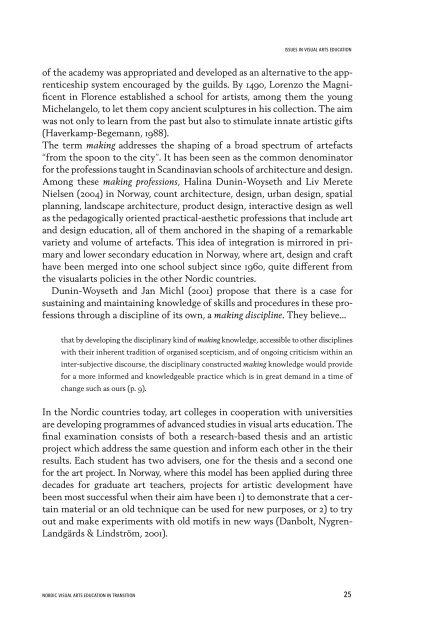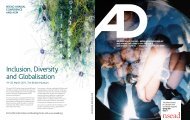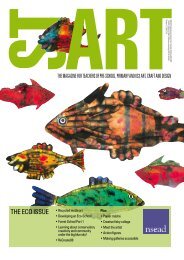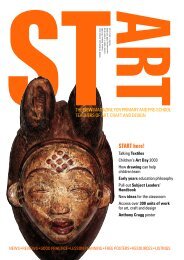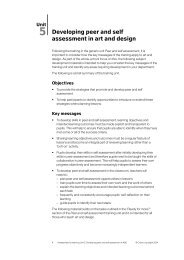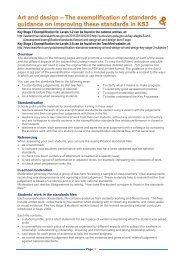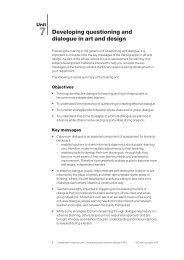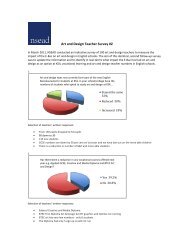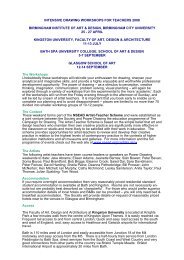Research in Visual Arts Education - Bilderlernen.at
Research in Visual Arts Education - Bilderlernen.at
Research in Visual Arts Education - Bilderlernen.at
Create successful ePaper yourself
Turn your PDF publications into a flip-book with our unique Google optimized e-Paper software.
ISSUES IN VISUAL ARTS EDUCATIONof the academy was appropri<strong>at</strong>ed and developed as an altern<strong>at</strong>ive to the apprenticeshipsystem encouraged by the guilds. By 1490, Lorenzo the Magnificent<strong>in</strong> Florence established a school for artists, among them the youngMichelangelo, to let them copy ancient sculptures <strong>in</strong> his collection. The aimwas not only to learn from the past but also to stimul<strong>at</strong>e <strong>in</strong>n<strong>at</strong>e artistic gifts(Haverkamp-Begemann, 1988).The term mak<strong>in</strong>g addresses the shap<strong>in</strong>g of a broad spectrum of artefacts“from the spoon to the city”. It has been seen as the common denom<strong>in</strong><strong>at</strong>orfor the professions taught <strong>in</strong> Scand<strong>in</strong>avian schools of architecture and design.Among these mak<strong>in</strong>g professions, Hal<strong>in</strong>a Dun<strong>in</strong>-Woyseth and Liv MereteNielsen (2004) <strong>in</strong> Norway, count architecture, design, urban design, sp<strong>at</strong>ialplann<strong>in</strong>g, landscape architecture, product design, <strong>in</strong>teractive design as wellas the pedagogically oriented practical-aesthetic professions th<strong>at</strong> <strong>in</strong>clude artand design educ<strong>at</strong>ion, all of them anchored <strong>in</strong> the shap<strong>in</strong>g of a remarkablevariety and volume of artefacts. This idea of <strong>in</strong>tegr<strong>at</strong>ion is mirrored <strong>in</strong> primaryand lower secondary educ<strong>at</strong>ion <strong>in</strong> Norway, where art, design and crafthave been merged <strong>in</strong>to one school subject s<strong>in</strong>ce 1960, quite different fromthe visualarts policies <strong>in</strong> the other Nordic countries.Dun<strong>in</strong>-Woyseth and Jan Michl (2001) propose th<strong>at</strong> there is a case forsusta<strong>in</strong><strong>in</strong>g and ma<strong>in</strong>ta<strong>in</strong><strong>in</strong>g knowledge of skills and procedures <strong>in</strong> these professionsthrough a discipl<strong>in</strong>e of its own, a mak<strong>in</strong>g discipl<strong>in</strong>e. They believe…th<strong>at</strong> by develop<strong>in</strong>g the discipl<strong>in</strong>ary k<strong>in</strong>d of mak<strong>in</strong>g knowledge, accessible to other discipl<strong>in</strong>eswith their <strong>in</strong>herent tradition of organised scepticism, and of ongo<strong>in</strong>g criticism with<strong>in</strong> an<strong>in</strong>ter-subjective discourse, the discipl<strong>in</strong>ary constructed mak<strong>in</strong>g knowledge would providefor a more <strong>in</strong>formed and knowledgeable practice which is <strong>in</strong> gre<strong>at</strong> demand <strong>in</strong> a time ofchange such as ours (p. 9).In the Nordic countries today, art colleges <strong>in</strong> cooper<strong>at</strong>ion with universitiesare develop<strong>in</strong>g programmes of advanced studies <strong>in</strong> visual arts educ<strong>at</strong>ion. Thef<strong>in</strong>al exam<strong>in</strong><strong>at</strong>ion consists of both a research-based thesis and an artisticproject which address the same question and <strong>in</strong>form each other <strong>in</strong> the theirresults. Each student has two advisers, one for the thesis and a second onefor the art project. In Norway, where this model has been applied dur<strong>in</strong>g threedecades for gradu<strong>at</strong>e art teachers, projects for artistic development havebeen most successful when their aim have been 1) to demonstr<strong>at</strong>e th<strong>at</strong> a certa<strong>in</strong>m<strong>at</strong>erial or an old technique can be used for new purposes, or 2) to tryout and make experiments with old motifs <strong>in</strong> new ways (Danbolt, Nygren-Landgärds & L<strong>in</strong>dström, 2001).NORDIC VISUAL ARTS EDUCATION IN TRANSITION 25


